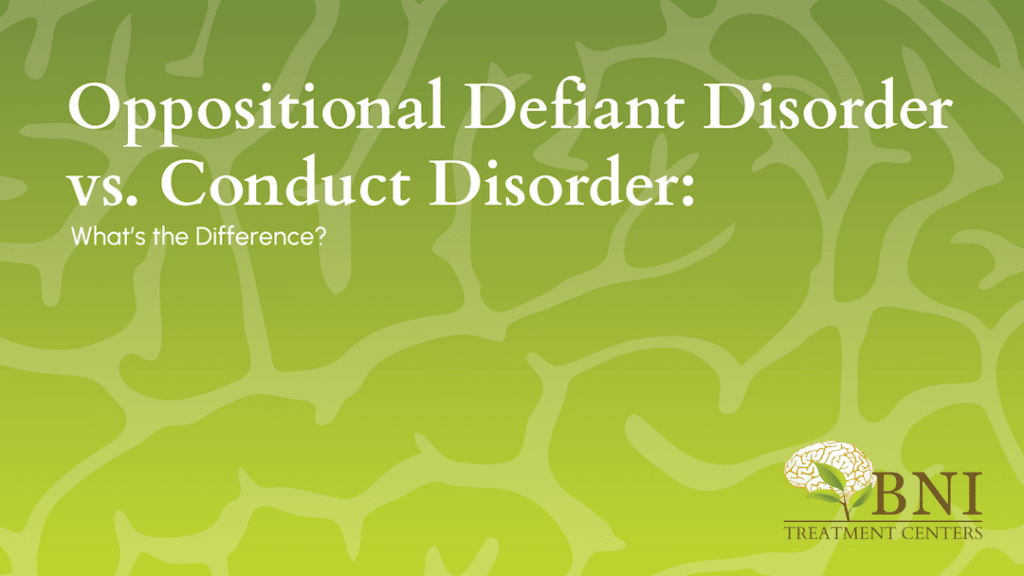
Research often suggests different rates of prevalence in these disruptive disorders. Why?
One reason is likely misdiagnosis. 60% of conduct disorder cases also meet the criteria for oppositional defiant disorder. Even among medical professionals, these conditions are easily confused, but knowing exactly where they overlap and differ is important.
We see these conditions frequently at BNI Treatment Centers. Oppositional defiant disorder and conduct disorder have several similarities. However, there are also key differences. Let’s explore this topic further.
What Is Oppositional Defiant Disorder (ODD)?
To accurately compare ODD and conduct disorder, it’s important to understand each condition individually.
Oppositional defiant disorder is a disruptive behavioral disorder characterized by these qualities:
- Emotional outbursts
- Breaking rules and resisting authority
- Blaming others
- Intentionally irritating others
- Resentment and vindictiveness
- Frequent and explosive anger and irritability
- Argumentativeness
Children with ODD can’t seem to help but rebel and disobey rules and authority figures.
A child must exhibit four or more of these symptoms for at least six months to qualify officially as having ODD. The symptoms must also occur with people other than their siblings and significantly impact their lives.
What Is the Difference Between ODD and Typical Teen Behavior?
While many teens sometimes exhibit behavior similar to ODD, there are key differences. The most significant is the frequency of the behavior. Teens without ODD will sometimes defy authority and push the boundaries of rules. They also may listen to certain authority figures more than others. Teens with ODD are defiant in every area of life. The behavior impacts their relationships, standing in school, and other aspects of their mental health.
Teens with ODD typically have a more explosive temper also. While all teens experience mood swings and outbursts sometimes, teens with ODD consistently become emotionally volatile over situations that most would consider inconsequential.
The consistency, frequency, and severity of the behavior is what separates typical teen behavior from ODD.

What Is Conduct Disorder?
The Diagnostic and Statistical Manual of Mental Disorders, Fifth Edition (DSM-5) defines conduct disorder as “a condition where a child intentionally violates rules and the rights of others.” These signs may appear as:
- Aggression towards other people or animals
- Destruction of property
- Frequent lying and deceptive behavior
- Bullying
- Skipping school
- Running away from home
- Attempting to intimidate others into activities they don’t want to engage in
- Stealing
- Causing fights
- Getting into legal trouble
Conduct disorder is a severe disruptive behavior disorder. It typically impacts teens’ lives even more significantly than ODD.
Similarities and Differences in Disruptive Behavior Disorders: Comparing ODD and Conduct Disorder
The primary similarity between disruptive behavior disorders like ODD and conduct disorder is in the name: disruptive behavior. However, there are several differences. See the chart below for a more detailed comparison.
ODD
- Manifests in early childhood
- Typically verbal defiance, not physical or violent
- Less severe overall than conduct disorder
ODD and Conduct Disorder
- Rebellious behavior and breaking of rules
- Risky and/or dangerous behavior
- Significantly influence every area of life
- Often co-occur with ADHD, depression, and/or anxiety
- Likely caused by similar factors, such as a difficult home life, a family history of mental health conditions, low frustration tolerance, etc
- Can be improved with treatment
- Aggressive behavior
Conduct Disorder
- Manifests later in childhood
- Less empathy
- More prone to violence
- Behavior and consequences are typically more severe
Note that ODD can progress into conduct disorder, and conduct disorder can shift into ODD. If you believe your child has one of these conditions, consulting a mental health professional is paramount. They can differentiate between ODD and conduct disorder and provide a diagnosis if appropriate.

Finding Treatment for Disruptive Behavior Disorders in Los Angeles
Managing disruptive behavior disorders alone is difficult. You likely lead a life of constantly arguing with your child, attempting to keep them out of trouble – and maybe even fearing for their safety or the safety of others. The good news is that this phase of your life and your child’s behavior won’t last forever. Help is available to improve your family’s situation.
It will inevitably be difficult to get a teen with a disruptive behavior disorder into treatment. However, it’s worth the effort. Rest assured – there are plenty of professionals trained to assist with your child’s condition, no matter how severe things might seem. We encourage you to reach out and seek behavioral health treatment.
BNI Treatment Centers works with Los Angeles teens to improve their mental health every day. Our expert clinicians don’t shy away from any condition, no matter how complex it may be. We are fully equipped to treat disruptive behavior disorders and any other mental health symptoms that occur alongside them. Your family deserves to live a more peaceful and stable life. Call (888) 522-1504 today for more on how we can help.
BNI Treatment Centers: Science-based, evidence-backed, compassion-led.




